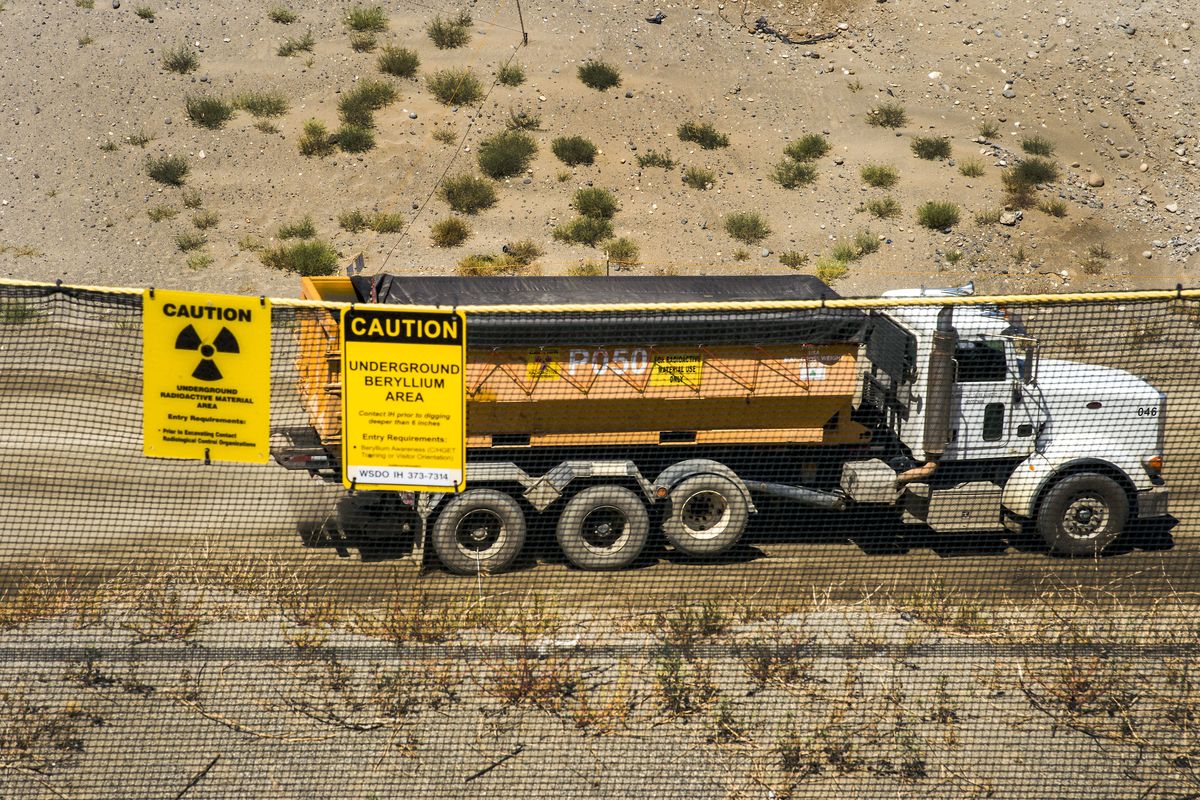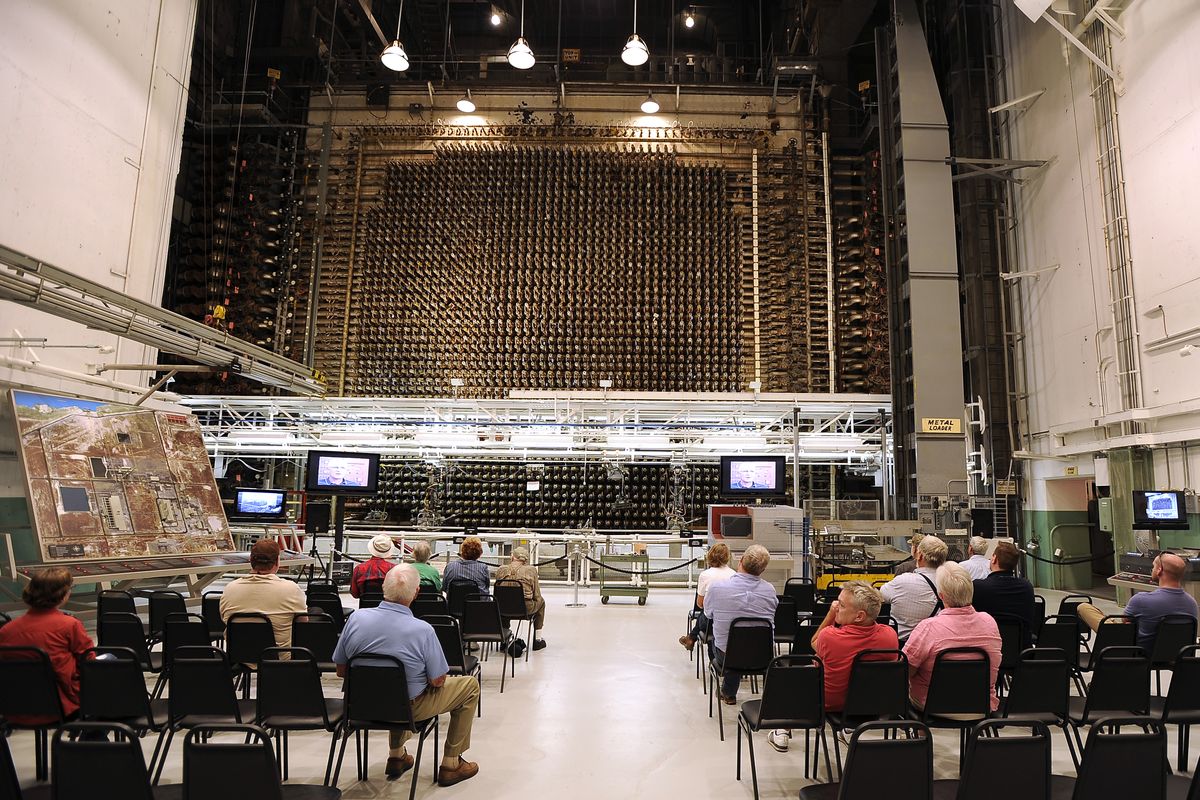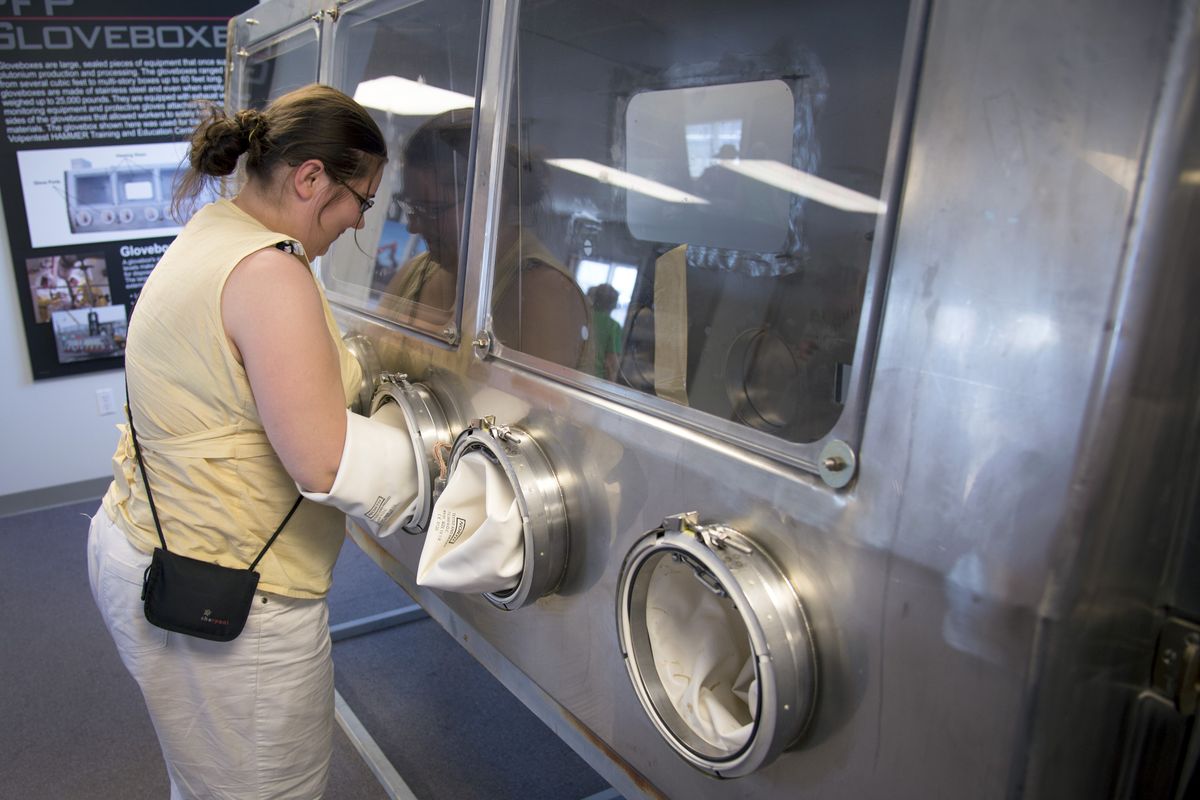Nuclear lessons: Hanford tours go to heart of Cold War facility
Inside the B Reactor, the world’s first full-scale plutonium production reactor, Hanford Site Public Tours participants watch a video while sitting in front of the deactivated reactor core where uranium was irradiated to produce plutonium used in the atomic bomb dropped on Nagasaki. (Colin Mulvany)Buy a print of this photo
RICHLAND – At Hanford’s B Reactor, thousands of graphite blocks towered over Ernie Doyle’s head.
On a recent public tour, the 57-year-old truck driver from Hillsboro, Oregon, seized the chance to take a close look at the world’s first large-scale nuclear reactor.
Uranium isotopes were loaded into aluminum tubes inside the graphite structure, setting off a chain reaction that produced plutonium.
The reactor was in full swing when Doyle’s dad worked at Hanford as a ferry operator in the late 1950s. But during the U.S.-Soviet arms race, making plutonium for the nation’s nuclear weapons arsenal was still a hush-hush affair.
“He knew something was going on” but no details, Doyle said of his father. “It’s amazing what they did here.”
Thousands of people visit Hanford each year on free tours conducted by the U.S. Department of Energy, taking advantage of the opportunity to see southeast Washington’s once off-limits nuclear site.
The tours are packed with information about Hanford’s role in the race to build an atomic bomb during World War II and its contribution to the Cold War’s nuclear stockpile. The tours also discuss environmental cleanup at the 586-square-mile site.
For Doyle, stopping at the B Reactor was a highlight of the bus tour. Plutonium from the reactor was used in the world’s first atomic blast, the 1945 Trinity test, and in the bomb dropped a few weeks later on Nagasaki, Japan.
In addition to the reactor’s core, Doyle was fascinated by the pre-computer technology in the control room.
Dee Gardner, a tour participant from Snoqualmie, Washington, was more interested in Hanford’s legacy of radioactive and chemical pollution. With $42 billion spent on cleanup, and another $115 billion in work remaining, the site ranks among the nation’s costliest cleanup efforts.
“I’m a taxpayer and I’m paying for this cleanup, so I have some ownership in it,” Gardner said.
Tours fill up quickly
The Department of Energy spends about $111,000 annually on the tours, which are part of public education and outreach efforts. Visitors can sign up for a four-hour bus tour of the site or a visit to the B Reactor. The tours fill up shortly after online registration opens in early March.
“Hanford was secret for so long that a lot of people want to see it,” said Rich Buel, the Department of Energy’s tour manager.
At half the size of Rhode Island, with 70 years of history and an annual budget of $2.2 billion, there’s a lot to take in at the sprawling Hanford complex, Buel said.
• The site is home to nine nuclear reactors, which produced plutonium from the 1940s to the 1980s.
The B Reactor has been preserved as a National Historic Landmark. Six of the other reactors have been “cocooned,” which means they’ve been demolished down to the shield walls around the reactors’ cores. Officials are mulling the use of remote robotics to tear down the reactors, or waiting up to 75 years for the radioactivity to decay so they could be safely torn down through conventional means.
• In one of Hanford’s most challenging environmental problems, 56 million gallons of radioactive and chemical waste are stored in 177 giant, underground tanks. Nearly 40 percent of the tanks are believed to have leaked.
Construction has begun on a treatment plant that will blend the waste with glass-forming materials and heat it to 2,100 degrees. In the inert glass form, the waste’s radioactivity will dissipate over hundreds to thousands of years.
“This is proven technology that can work at Hanford,” said Dieter Bohrmann, a spokesman for the Washington Department of Ecology’s nuclear waste program.
But the Department of Energy says it can’t meet the 2019 deadline for starting up the treatment plant, which was part of a legal settlement involving the state, the Energy Department and the U.S. Environmental Protection Agency. State and federal officials are in dispute resolution talks to set a new deadline.
“Time is not on our side,” said Bohrmann, noting that most of the tanks are decades past their intended life span.
• A plume of polluted groundwater covers 60 square miles at Hanford, the legacy of 450 billion gallons of contaminated liquids and wastewater that was poured directly into the soil. The plume is being treated to slow its movement toward the Columbia River.
• Hanford had more than 1,000 waste sites, some of them old dumps where laboratory waste was disposed without records. Cleanup of a single site can require months of research. The Department of Energy touts the cleanup of nearly 900 waste sites as a remediation milestone.
“You can read about Hanford. You can hear about it in 90-second TV spots,” Buel said. “But when you actually come and see the places with your own eyes, you get a better sense of the challenges and the progress.”
Sagebrush and security gates
From the windows of the tour bus, Hanford unfolds as a parched landscape of sagebrush and security gates. On a 100-degree afternoon, the bus’s air-conditioning system is no match for the Columbia Basin’s heat.
Scraggly clusters of locust trees and a few collapsing buildings mark the former town sites of Hanford and White Bluffs. About 1,500 people once lived in the small communities along the Columbia River.
In 1943, they were given a month’s notice to leave. The United States and its allies were in a race to develop the atomic bomb before the Germans, and the government had selected the Hanford area for plutonium production.
Grand Coulee Dam supplied electricity for the project. The Columbia River provided cooling water for the nuclear reactors.
During Hanford’s construction, more than 50,000 people worked at the site, building the first nuclear reactors and processing facilities. But only a handful of top officials knew the site’s mission, Buel said.
FBI agents made up about 15 percent of Hanford’s workforce. Workers who asked too many questions, or expressed curiosity about what they were building in the desert, were fired.
“They found themselves on the next day’s train,” Buel said.
After World War II ended, Hanford became part of the Cold War effort. About two-thirds of the plutonium in the nation’s nuclear stockpile was made at the site.
Each half-pound of plutonium produced required about a ton of raw materials, generating enormous amounts of radioactive and chemical waste.
By the late 1980s, Hanford’s last nuclear reactor had shut down. But 20 tons of plutonium – molded into the shape of hockey pucks and stored in a vault – remained at Hanford until five years ago, when it was shipped to a Department of Energy facility in South Carolina.
Seattle resident Lee Pyne-Mercer made the 3 1/2-hour drive to Richland for the tour. He left with a better understanding of Hanford’s place in history, and the magnitude of the work ahead.
“I was a child of the Cold War,” said Pyne-Mercer, 42. “I’m sort of a news junkie, and this is a big, expensive project.”
One of the tour stops is a high-tech landfill, where 16 million tons of low-level radioactive waste have been disposed of over the past two decades.
But it will take another 56 years to finish Hanford’s cleanup, according to a recent status report prepared under the 1989 Tri-Party agreement, the pact among the state of Washington, the EPA and the Energy Department that governs the site’s remediation.
In reality, “it’s hard to say what Hanford’s end date will be,” said the Department of Ecology’s Bohrmann.




